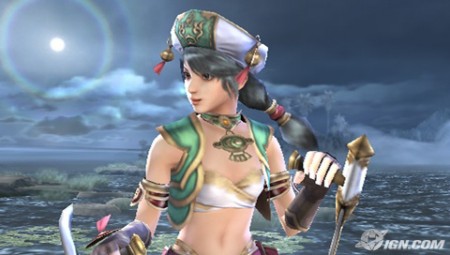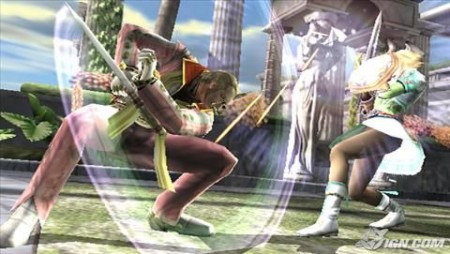
SoulCalibur Broken Destiny JPN READNFO PSN PSP-PLAYASiA
English | Platform: PSP | Release: February 4, 2012 | Publisher: Namco Bandai | Developer: Project Soul | 346 MB
Genre: Fighting
With Namco Bandai's Soulcalibur IV hitting current-gen consoles last year, it was hard to imagine the renowned 3D fighter functioning on a portable console. After all, the Soulcalibur series -- which pits warriors against each other in a world filled with ethereal weapons -- has always been a visual powerhouse. Squeezing all the character detail, lighting effects and lush backgrounds onto a UMD seemed like an awful idea.
Fortunately, Soulcalibur: Broken Destiny preserves the Soulcalibur tradition beautifully and recreates the weapon-based combat exclusively for Sony's PSP. These are really amazing portable visuals.
Broken Destiny is, ultimately, a portable version of its console counterpart. It packs most of the characters, levels and modes that Soulcalibur fans are familiar with and only drops a few bits and pieces along the way. Like the other Soulcalibur games before it, Broken Destiny is a 3D fighting game that pits two fighters against each other in large, open arenas. Players must battle their opponent by gauging timing, distance and location in the ring -- as characters can be knocked off the edge when struck or thrown properly.
The only noticeable differences between Soulcalibur: Broken Destiny and Soulcalibur IV are the toned down graphics and the absence of the Star Wars characters... which I am personally very happy about. As "interesting" as it was to see Darth Vader and Yoda (and the Apprentice) make guest appearances in the Soulcalibur universe, Broken Destiny's Kratos makes much more sense when considering the game's setting. The only other elements worth noting that were removed from the formula are the many unlockables and extras that have traditionally gone hand-in-hand with Soulcalibur games. Broken Destiny doesn't have many extras to speak of, though you will be spending quite a bit of time unlocking items for character creation and earning special honors for your Records.
One of the first things players will notice about Broken Destiny is the visuals. Although the game isn't as eye-catching as its PS3 predecessor, Broken Destiny is one of the best-looking PSP games I've ever played. It's really stunning how much was crammed onto a single UMD and watching these characters clash on such beautiful backdrops is a testament to the PSP's hardware. With little slowdown to speak of, this game deserves special credit just for its looks. I know that sounds shallow, but it's the truth.
Broken Destiny has several options for jumping into battle. You can opt for playing a Quick Match, which is exactly that: a single battle with a foe. There are also Trials to face, which are essentially survival-style modes that task you with racking up points and keeping your character alive. Then there's Ad Hoc multiplayer, a Creation tool for building your own characters and the standard Training mode.
The mode that takes the longest to "complete," however, is the Gauntlet. This story-driven, mission-based affair occupies a universe outside of the canonical Soulcalibur narrative. It's a comical story about you (and whichever character you select) following Hilde and her party around the world as they search for medicine for Hilde's father. It has little to do with the actual Soulcalibur story and is more fun and games than anything else.
Each mission in the Gauntlet is comprised of several mini-sections that only last a second or two each. Usually, you're only objective during these brief few moments is to survive a series of attacks and then counter appropriately. With this in mind, it's safe to say that the Gauntlet is more of an instructional tool than anything else, as your failures are greeted with helpful text that give you the steps needed to emerge victorious.
Although this sounds like a great way to teach new players the Soulcalibur way, I found this mode to be extremely repetitive after a while. I continued playing it just to see the humorous story play out, but by the end I was more than ready to move on. This could be due to the fact that I played through the mode with a single character -- perhaps switching it up halfway through the quest would have been more exciting.
But at the heart of this quest and the aforementioned visuals are Soulcalibur mechanics, which have come a long way since their original conception. The battle mechanics in Broken Destiny are very similar to those found in Soulcalibur IV, including the newer features like the Soul Gauge, Soul Crushes and Critical Finishes. If you're unfamiliar with these terms, it's actually quite simple: if your opponent guards too much, you can wear down his or her Soul Gauge and eventually break one of three pieces of armor on the character. Once you get your opponent's Soul Gauge in a miserable enough state, you can execute a Critical Finish, which ends the match in your favor (and displays some fancy special effects).
Although I've never been a hardcore devotee of the Soulcalibur fighting engine, I very much appreciate the amount of variety and strategy that goes into studying each character. Having to balance out blocking, sidestepping, Guard Impacts and more make this a very, very difficult game to master. But at the same time, Soulcalibur has always been a fighting game that can be picked up easily. As moves rarely require complex directional inputs or button combinations, most gamers can at least pick up the controller and mash away for fun (much to the chagrin of veteran competitors).
The icing on the cake in Soulcalibur: Broken Destiny is definitely the Ad Hoc multiplayer. As battling with a friend is a tremendous part of the fighting game experience, having such smooth running Ad Hoc makes the package much more appetizing. During my play tests, I rarely -- if ever -- encountered any slowdown. Thank goodness.
CLOSING COMMENTS
Although Broken Destiny is nothing more than a portable version of Soulcalibur IV (with Kratos along for the ride), the game is visually stunning and the size of the roster is admirable. What's most impressive about Soulcalibur: Broken Destiny is how well it preserves its console counterpart's formula while making very few sacrifices along the way.
Although it's hard for me to strongly recommend this game if you already own Soulcalibur IV, it's safe to say that this is one of the most beautiful, complex fighting games on the PSP and should please Soulcalibur fans. The developers should be praised for making the game work so well on the PSP, even though we've seen most of it before.
Link Download
From Extabit
From Ul.to (Premium Recommend)




 Posted in:
Posted in: 



0 commenti:
Post a Comment